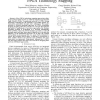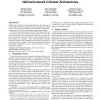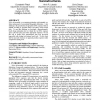DAC
2006
ACM
15 years 9 months ago
2006
ACM
In a placed circuit, there are a lot of movable cells that can be flipped to further reduce the total wirelength, without affecting the original placement solution. We aim at solv...
DAC
2006
ACM
15 years 9 months ago
2006
ACM
Most FPGA technology mapping approaches either target Lookup Tables (LUTs) or relatively simple Programmable Logic Blocks (PLBs). Considering networks of PLBs during technology map...
DAC
2006
ACM
15 years 9 months ago
2006
ACM
Highly regular, nanodevice based architectures have been proposed to replace pure CMOS based architectures in the emerging post CMOS era. Since bottom-up self-assembly is used to ...
DAC
2006
ACM
15 years 9 months ago
2006
ACM
In this paper we propose a hybrid FPGA using nanoscale clusters with an architecture similar to clusters of traditional CMOS FPGAs. The proposed cluster is made of a crossbar of n...
DAC
2006
ACM
15 years 9 months ago
2006
ACM
In this paper, a Triangularization Based Structure preserving (TBS) model order reduction is proposed to verify power integrity of on-chip structured power grid. The power grid is...
DAC
2006
ACM
15 years 9 months ago
2006
ACM
DNA self-assembly is an emerging technology with potential as a future replacement of conventional lithographic fabrication. A key challenge is the specification of appropriate DN...
DAC
2006
ACM
15 years 9 months ago
2006
ACM
This article outlines several projects aimed at generating electrical energy by passively tapping a variety of human body sources and activities. After summarizing different energ...
DAC
2006
ACM
15 years 9 months ago
2006
ACM
Formal languages are increasingly used to describe the functional requirements (specifications) of circuits. These requirements are used as a means to communicate design intent an...
DAC
2006
ACM
15 years 9 months ago
2006
ACM
Designing an energy efficient power gating structure is an important and challenging task in Multi-Threshold CMOS (MTCMOS) circuit design. In order to achieve a very low power des...
DAC
2006
ACM
15 years 9 months ago
2006
ACM
Networks-on-Chip (NoC) architectures provide a scalable solution to on-chip communication problem but the bandwidth offered by NoCs can be utilized efficiently only in presence of...



